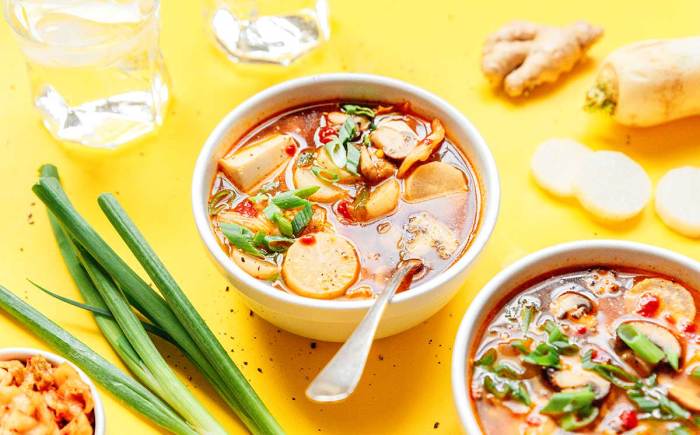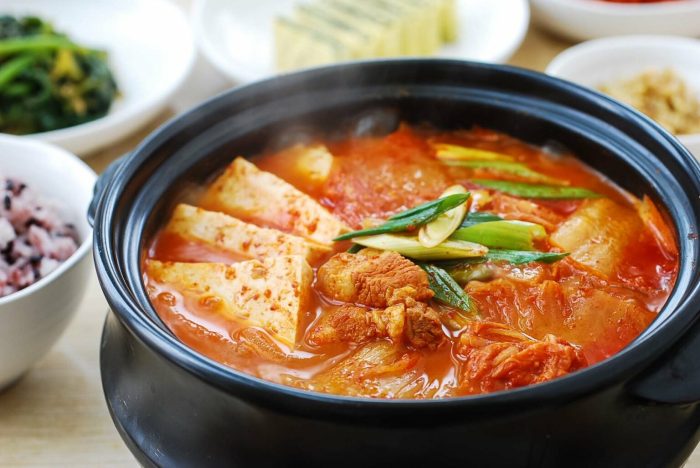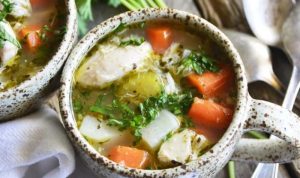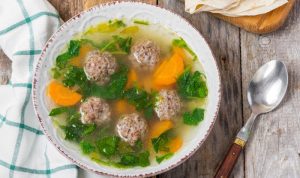Kimchi Soup: A Culinary Journey

Source: liveeatlearn.com
Kimchi soup recipes – Kimchi jjigae, or kimchi soup, is a staple in Korean cuisine, a vibrant and flavorful stew deeply rooted in history and tradition. Its popularity extends beyond Korea’s borders, captivating palates worldwide with its unique blend of spicy, sour, and savory notes. This exploration delves into the history, nutritional benefits, preparation, and cultural significance of this beloved dish, offering a comprehensive guide to crafting your own perfect bowl of kimchi soup.
Introduction to Kimchi Soup
Kimchi soup’s origins trace back centuries, evolving alongside kimchi itself. Regional variations abound, with ingredients and preparation methods adapting to local tastes and available resources. In some regions, a richer, heartier broth is preferred, while others favor a lighter, more broth-based approach. The common thread is the use of kimchi, a fermented cabbage dish, as the star ingredient, providing the characteristic sourness and spiciness.
Kimchi’s fermentation process enhances its nutritional value, making the soup a powerhouse of probiotics, vitamins, and antioxidants. The key ingredients, kimchi, gochujang (Korean chili paste), and gochugaru (Korean chili flakes), contribute significantly to the soup’s health benefits and distinct flavor profile.
Sharing kimchi jjigae is a common practice during family gatherings and celebrations in Korea. It’s often considered a comforting and nourishing meal, particularly during colder months. The act of sharing a warm bowl of soup fosters a sense of community and togetherness.
Essential Ingredients for Kimchi Soup
The following table Artikels the essential ingredients for a classic kimchi soup recipe. The role of each ingredient in shaping the flavor and texture is described below the table. Suitable substitutions are also considered, ensuring accessibility for various dietary needs and preferences.
| Ingredient Name | Quantity | Type | Notes |
|---|---|---|---|
| Kimchi | 1 cup, chopped | Fermented Vegetable | Use a well-fermented kimchi for optimal flavor. |
| Gochujang | 1-2 tablespoons | Chili Paste | Adjust quantity to control spiciness. |
| Gochugaru | 1 teaspoon | Chili Flakes | Adds color and heat. |
| Soy Sauce | 1 tablespoon | Seasoning | Adds umami and saltiness. Can be substituted with tamari for gluten-free option. |
| Garlic | 2 cloves, minced | Aromatics | Enhances flavor. |
| Ginger | 1 inch piece, minced | Aromatics | Adds warmth and depth. |
| Onion | 1/2, chopped | Aromatics | Adds sweetness and texture. |
| Vegetable Broth or Water | 4 cups | Liquid | Use broth for a richer flavor. |
| Tofu (optional) | 1/2 block, cubed | Protein | Adds protein and texture. Can be substituted with mushrooms or other vegetables. |
| Green Onions (optional) | 2 stalks, chopped | Garnish | Adds freshness and visual appeal. |
The kimchi provides the foundation of the soup’s flavor profile, contributing its signature sourness and spice. Gochujang and gochugaru amplify the spiciness and depth of flavor, while soy sauce balances the overall taste with saltiness and umami. Garlic and ginger add warmth and aromatic complexity, complemented by the sweetness of the onion. Tofu or other additions provide protein and textural contrast.
Variations of Kimchi Soup Recipes
Kimchi soup recipes exhibit considerable diversity. Three distinct variations are highlighted below, each with unique characteristics in preparation and ingredient combinations. A creative variation incorporating less common ingredients is also presented.
Variation 1: Classic Kimchi Soup: This version emphasizes the balance of kimchi’s sourness with the savory depth of the broth. It often includes tofu, onions, and green onions.
Variation 2: Seafood Kimchi Soup: This variation incorporates various seafood such as clams, mussels, or shrimp, adding a briny element to the soup’s flavor profile. The seafood’s natural sweetness complements the kimchi’s tanginess.
Variation 3: Pork Kimchi Soup: Pork belly or other cuts of pork are added for a richer, more substantial soup. The pork’s fattiness enhances the soup’s mouthfeel and complements the other flavors.
Creative Variation: Kimchi Soup with Kimchi Pancakes: This unique variation adds small pieces of fried kimchi pancakes to the soup. The crispy texture of the pancakes contrasts beautifully with the soup’s broth, offering a delightful textural experience. The addition of the pancakes intensifies the kimchi flavor.
Step-by-Step Kimchi Soup Recipe
This recipe details the preparation of a classic kimchi soup. Precise timing and temperature control are crucial for achieving the optimal balance of flavors and textures.
- Step 1: Sauté Aromatics: Heat a tablespoon of oil in a pot over medium heat. Add minced garlic and ginger, sautéing until fragrant (approximately 1 minute). The aroma is pungent and fragrant, indicating the aromatics are releasing their essential oils.
- Step 2: Add Kimchi and Gochujang: Add chopped kimchi and gochujang to the pot. Stir well, cooking for another 2-3 minutes until the kimchi softens slightly and releases its flavors. The kimchi will begin to release its vibrant red color into the oil.
- Step 3: Incorporate Broth and Seasonings: Pour in vegetable broth (or water), soy sauce, and gochugaru. Bring the mixture to a boil, then reduce heat and simmer for 10-15 minutes. This allows the flavors to meld together and deepen.
- Step 4: Add Tofu (Optional): Add cubed tofu (or other protein) and simmer for another 5-7 minutes until heated through. The tofu absorbs the flavors of the broth, becoming tender and flavorful.
- Step 5: Garnish and Serve: Garnish with chopped green onions before serving. The vibrant green of the onions provides a pleasing visual contrast against the red of the kimchi.
Serving Suggestions and Pairings
Kimchi soup is best enjoyed with complementary side dishes and beverages. The following suggestions enhance the overall dining experience.
- Steamed rice
- Pan-fried mandu (dumplings)
- Kimchi pancakes
- Various banchan (Korean side dishes)
Traditionally, kimchi soup is paired with rice, allowing for a balanced and satisfying meal. Other side dishes add variety and enhance the flavors of the soup. Korean rice wine (makgeolli) or soju are common beverage pairings, complementing the soup’s spiciness.
Troubleshooting Common Kimchi Soup Issues
Several common issues can arise during kimchi soup preparation. Understanding the causes and implementing solutions ensures a successful outcome.
| Problem | Cause | Solution | Prevention |
|---|---|---|---|
| Overly Salty | Excessive soy sauce or salty kimchi | Add more broth or water to dilute the saltiness. | Use less soy sauce and taste the kimchi before adding salt. |
| Too Spicy | Excessive gochujang or gochugaru | Add a spoonful of sugar or honey to balance the spiciness. | Start with less chili paste and flakes, adjusting to taste. |
| Bland | Insufficient seasoning or under-fermented kimchi | Add more soy sauce, gochujang, or gochugaru to taste. | Use well-fermented kimchi and adjust seasoning accordingly. |
Kimchi Soup Recipe Adaptations

Source: rukita.co
Kimchi soup can be adapted to accommodate various dietary needs and preferences. Modifications for spiciness and flavor are also discussed.
Vegetarian/Vegan: Omit the pork or seafood and ensure that the broth used is vegetarian or vegan-friendly. The addition of mushrooms or other hearty vegetables can enhance the texture and flavor.
Gluten-Free: Use tamari or coconut aminos instead of soy sauce.
Adjusting Spiciness: Control the spiciness by adjusting the amount of gochujang and gochugaru. Adding a touch of sugar or honey can also help balance the heat.
Making Ahead and Storing: Kimchi soup can be made in advance and stored in the refrigerator for up to 3 days. The flavors will deepen over time, resulting in a richer and more complex taste. Reheat gently before serving.
FAQs: Kimchi Soup Recipes
Can I use store-bought kimchi?
Kimchi soup recipes offer a vibrant, spicy flavor profile, often featuring fermented cabbage and a rich broth. For a different kind of hearty and flavorful soup, you might explore the comforting world of pinto bean soup recipes , which offer a completely different taste experience. Returning to kimchi, the variations in spice level and ingredient additions make it endlessly adaptable for diverse palates.
Absolutely! Store-bought kimchi works perfectly well. Just be mindful of its saltiness and adjust the seasoning accordingly.
How long can I store leftover kimchi soup?
Leftover kimchi soup can be stored in an airtight container in the refrigerator for up to 3-4 days.
Can I make kimchi soup ahead of time?
Yes, you can prepare the soup a day in advance. The flavors will meld beautifully, creating an even richer taste. Reheat gently before serving.
What if my kimchi soup is too spicy?
Add a dollop of plain yogurt or a splash of milk or cream to reduce the spiciness. A spoonful of sugar can also help balance the heat.






